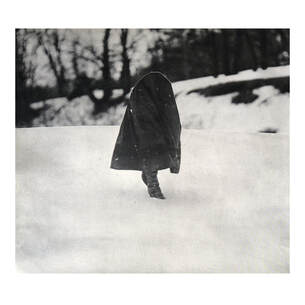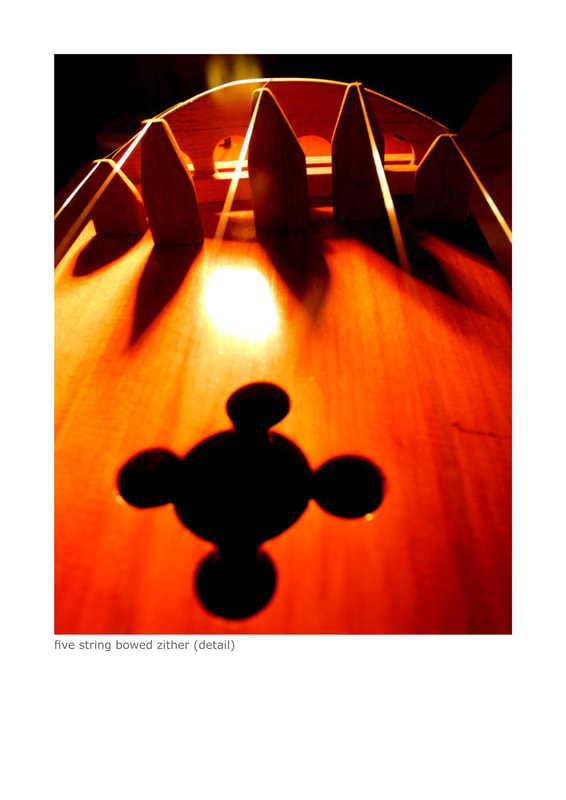|
|
In Music Born of Solitude I returned to the world of note-based music in order to work with the Eikosany, a twenty-tone just intonation structure devised by American theorist Erv Wilson. I also returned to instrument building, taking time to make a quartet of five-stringed bowed zithers, two large and two small with cedar or spruce tops, beech sides, exotic ply bottom and oak bridges. 4 instruments x 5 strings = 20 tones. I then applied my continually developing interest in what I’d call a sound-as-sound aesthetic to the instrumental material. Some images can be seen here (scroll down)
The zithers were bowed and ebowed (activated using an electronic device, the ebow) and the sounds of both merged together for each tone. The four parts of the score were recorded individually, then the work was assembled digitally. An offset digitally reversed version of the original formed a second layer, creating a retrograde canon, a device favoured by early choral composers. My intention was to offer the listener as close as possible the sound of a justly-intoned quartet of acoustic instruments. The work could of course be convincingly performed using a polyphonic tunable synthesiser. Working with the Eikosany is simple on one level but quite complex at another. I chose to compose using four tone tetrads of the 1.3.5.7.9.11 eikosany. In scoring the work I had to jump constantly between frequencies designated by Herz, assigned note names with inflections (A^, B* etc.) and the numerical method of naming the harmonic and subharmonic tetrads themselves (1.3.5.7, 1/3.5.7.11 etc.) Put simply, I managed to create a series of harmonic structures in which all twenty tones were used and where all structures flowed from one to the other connected by commontones. In spite of the complexity in scoring the work the music is likely to be heard as calm and serene in nature. I’ll leave it there and invite the reader to explore just intonation further at his or her leisure. Music Born of Solitude was hosted on the digital platform con-v, then released as a self published cdr. It's now available as a Bandcamp digital download. The Eikosany was devised by theorist Erv Wilson and has been developed over many years by composer, instrument builder and theorist Kraig Grady, whom I had the good fortune to meeting in Scotland in 2013 and to whom I am indebted for advice and guidance over the years. Using this tuning in 2004 I composed the 8 channel work Hannah Throwing Stones - a version for electronics and a version for double string quintet. In 2005 I wrote Slow Kotekans Breaking for tuned sine waves. From 2007-2009 I designed and built a quartet of 5-string bowed zithers which gave me the twenty tones of the Eikosany in a homogenous string ensemble. For this quartet of instruments I wrote Music Born of Solitude in 2010. For a clear understanding of the Eikosany (well worth the effort if you're looking for new musical resource) an article from the Anaphorian archives (pdf) will explain everything, but I should mention that it requires time and patience.
Resources Instrument Making Making Simple Musical Instruments (Lark Books 1995) - Bart Hopkin. Sound Designs: A Handbook of Musical Instrument Building (Ten Speed Press 1995) - Reinhold Banek and John Scoville. Genesis of a Music (Da Capo Press 1974) - Harry Partch. Tuning Divisions of the Tetrachord (Frog Peak Music 1993) - John H. Chalmers Jr. Harmonic Experience (Inner Traditions 1997) - W.A. Mathieu. Tuning, Timbre, Spectrum, Scale (Springer 1999) - William A. Sethares. Acoustics On the Sensations of Tone (Dover Publications Inc. 1954) - Hermann Helmholtz. Fundamentals of Musical Acoustics (Dover Publications Inc. 1990) - Arthur H. Benade. Web Stephen James Taylor's online video about the work of Erv Wilson. The Anaphorian site - an archive of seminal theoretical documents on Just Intonation tuning systems (all generously made available for free download). Cris Forster's site - this is how my instruments were meant to look. |

